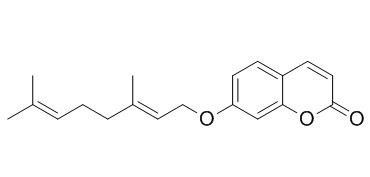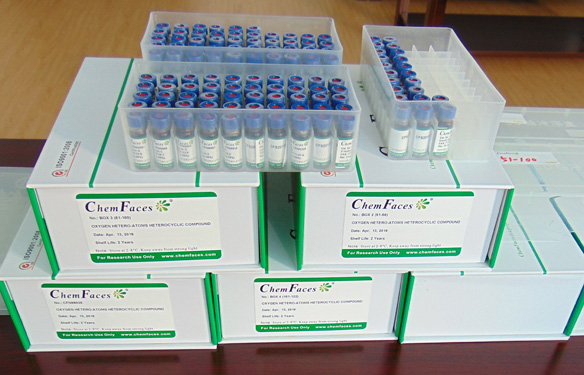Auraptene
Auraptene possesses anticarcinogenic, cardioprotective, anti-inflammatory, anti-oxidant, antihelicobacter, antigenotoxic, and neuroprotective effects. Auraptene has a potential to attenuate chronic inflammation in adipose tissue and to improve obesity-related insulin resistance, and has protective effects in transgenic rats developing adenocarcinoma of the prostate (TRAP) and human prostate carcinoma cells.
Inquire / Order:
manager@chemfaces.com
Technical Inquiries:
service@chemfaces.com
Tel:
+86-27-84237783
Fax:
+86-27-84254680
Address:
1 Building, No. 83, CheCheng Rd., Wuhan Economic and Technological Development Zone, Wuhan, Hubei 430056, PRC
Providing storage is as stated on the product vial and the vial is kept tightly sealed, the product can be stored for up to
24 months(2-8C).
Wherever possible, you should prepare and use solutions on the same day. However, if you need to make up stock solutions in advance, we recommend that you store the solution as aliquots in tightly sealed vials at -20C. Generally, these will be useable for up to two weeks. Before use, and prior to opening the vial we recommend that you allow your product to equilibrate to room temperature for at least 1 hour.
Need more advice on solubility, usage and handling? Please email to: service@chemfaces.com
The packaging of the product may have turned upside down during transportation, resulting in the natural compounds adhering to the neck or cap of the vial. take the vial out of its packaging and gently shake to let the compounds fall to the bottom of the vial. for liquid products, centrifuge at 200-500 RPM to gather the liquid at the bottom of the vial. try to avoid loss or contamination during handling.
Evid Based Complement Alternat Med.2015, 2015:165457
Front Pharmacol.2022, 13:806869.
J Agric Food Chem.2024, 72(45):25219-25228.
Int J Mol Sci.2021, 22(14):7324.
J Agric Food Chem.2024, 72(49):27139-27149
Biomedicine & Pharmacotherapy2020, 125:109950
Microchemical Journal2023. 191:108938
Horticulture Research2022, uhac276.
Molecules.2018, 23(3):E615
Phytomedicine.2019, 65:153089
Related and Featured Products
Eur J Pharmacol. 2015 Mar 5;750:8-13.
Auraptene has the inhibitory property on murine T lymphocyte activation.[Pubmed:
25620131]
Auraptene, a citrus fruit-derived coumarin, has been reported to exert valuable pharmacological properties as anti-tumor, anti-inflammatory, and anti-oxidant agent. However, little is known about Auraptene on immune responses.
METHODS AND RESULTS:
In this study, we conducted an investigation to evaluate Auraptene as an anti-T lymphocyte proliferation agent using CD3/CD28-activated lymphocytes isolated from C57BL/6 mice. We found that administration of Auraptene inhibited CD3/CD28-activated lymphocyte proliferation in a dose dependent manner, but the inhibition at a wide range of doses used in this study did not induce cytotoxicity or apoptosis. In addition, Auraptene dose dependently decreased the CD3/CD28-activated T lymphocyte secreting T helper (Th)1 cytokines (interleukin (IL)-2 and interferon (IFN)-γ); whereas, Auraptene could decrease Th2 cytokine (IL-4) at a higher level (40μM) but had not at lower levels (10 and 20μM). Further mechanistic study demonstrated that Auraptene doses dependently suppressed T cell early and middle/late activation marker CD69 and CD25 expression, respectively. Finally, Auraptene could suppress cell cycle progression which contributes to inhibiting T cell proliferation and cell division.
CONCLUSIONS:
These findings indicate that Auraptene exhibits anti-inflammatory properties via inhibiting T cell proliferation and their inflammatory cytokine secretion that may mediate the interaction between T cells and autoimmune disorders, suggesting that Auraptene is a potential food-derived compound with a benefit to those with abnormally over-activation T cell mediated response and chronic inflammation such as autoimmune and inflammatory diseases.
Inflammation. 2013 Dec;36(6):1525-32.
Anti-inflammatory effect of auraptene extracted from trifoliate orange (Poncirus trifoliate) on LPS-stimulated RAW 264.7 cells.[Pubmed:
23872723]
Poncirus trifoliate is a traditional Chinese medicinal plant used for treating inflammation-related diseases for a long time and trifoliate orange contains abundant Auraptene.
METHODS AND RESULTS:
The present study was to evaluate Auraptene as a potential anti-inflammatory agent and investigate the mechanism of Auraptene against prostaglandins E2 (PGE2) and cyclooxygenase-2 (COX-2) on lipopolysaccharide (LPS)-stimulated RAW 264.7 cells by comparing it with aspirin as a positive control group. The methods of enzyme-linked immunosorbent assay, reverse transcriptive polymerase chain reaction, real-time PCR, and western-blotting were used in the study. The results showed that Auraptene exhibited better biocompatibility and lower cytotoxicity. At the same time, it significantly inhibited the production of PGE2 on LPS-stimulated macrophage cells. The Auraptene-treated group had a higher COX-2 mRNA expression but relatively lower COX-2 protein level which implied that Auraptene suppressed the post-transcriptional expression of COX-2 protein but not the transcriptional process.
CONCLUSIONS:
Compared with aspirin, the lower cytotoxicity of Auraptene can make it a potential source for medicine that can benefit patients who are suffering from chronic inflammatory diseases and need long-term medication.
Iran J Basic Med Sci. 2015 Feb;18(2):153-8.
Antihypertensive effect of auraptene, a monoterpene coumarin from the genus Citrus, upon chronic administration.[Pubmed:
25810889]
Auraptene, a monoterpene coumarin from Citrus species, exhibits cardioprotective effects. In this study, the effects of Auraptene administration were investigated on blood pressure of normotensive and desoxycorticosterone acetate (DOCA) salt induced hypertensive rats.
METHODS AND RESULTS:
Five weeks administration of Auraptene (2, 4, 8 and 16 mg/kg/day) and nifedipine (0.25, 0.5, 1, 2 and 4 mg/kg/day) in different groups of normotensive and hypertensive rats (at the end of 3 weeks treatment by DOCA salt) was carried out and their effects on mean systolic blood pressure (MSBP) and mean heart rate (MHR) were evaluated using tail cuff method.
Our results indicated that chronic administration of Auraptene (2, 4, 8 and 16 mg/kg/day) significantly reduced the MSBP in DOCA salt treated rats in a dose and time dependent manner. The percent of decreases in MSBP levels by the highest dose of Auraptene (16 mg/kg) at the end of 4 (th) to 8 (th) weeks, were 7.00%, 10.78%, 16.07%, 21.28% and 27.54% respectively (P<0.001). Moreover the antihypertensive effect of Auraptene was less than nifedipine (ED50 value of nifedipine = 0.7 mg/kg at 8(th) week and ED50 value of Auraptene = 5.64 mg/kg at 8 week).
CONCLUSIONS:
Auraptene considerably reduced MSBP in hypertensive rats, but not in normotensive (normal saline treated) rats. The results of MHR measurement showed that the increase in MHR was not significant in comparison with DOCA treated rats.
J Alzheimers Dis. 2015;43(4):1215-28.
Auraptene increases the production of amyloid-β via c-Jun N-terminal kinase-dependent activation of γ-secretase.[Pubmed:
25147119]
Amyloid-β (Aβ) peptide plays a major role in the pathogenesis of Alzheimer's disease (AD), and is generated by β- and γ-secretase-mediated proteolytic processing of amyloid-β protein precursor (AβPP).
METHODS AND RESULTS:
In the present study, we investigated the effect of 118 natural compounds on Aβ production in the medium of HEK293 cells stably expressing human AβPP695 (HEK293-AβPP) using Aβ42 sandwich ELISA to find natural compounds that can modulate Aβ production. We found that a coumarin derivative of citrus fruits, Auraptene, increased Aβ production. Treatment of HEK293-AβPP cells and rat primary cortical neurons with Auraptene significantly increased the secretion of Aβ40, Aβ42, and the Aβ42/40 ratio. However, Auraptene did not change the protein levels of the AβPP processing enzymes, a disintegrin and metalloproteinases 10 (ADAM10, α-secretase), β-site AβPP cleaving enzyme-1 (BACE-1, β-secretase), and presenilin 1 (PS1, γ-secretase component). Auraptene increased the activity of γ-secretase but not that of α- and β-secretase. Furthermore, Auraptene enhanced γ-secretase-mediated production of Aβ from AβPP or AβPP-C99, but not through α- and β-secretase. Auraptene also phosphorylated c-Jun N-terminal kinase (JNK), and pretreatment with the JNK inhibitor, SP600125, reduced Auraptene-induced γ-secretase activity.
CONCLUSIONS:
Overall, our results suggest that Auraptene-mediated activation of JNK may contribute to the production of Aβ by promoting γ-secretase activity.
Mol Nutr Food Res. 2013 Jul;57(7):1135-44.
Auraptene suppresses inflammatory responses in activated RAW264 macrophages by inhibiting p38 mitogen-activated protein kinase activation.[Pubmed:
23495198]
Inflammation plays a key role in obesity-related pathologies such as insulin resistance and type 2 diabetes. Hypertrophied adipocytes trigger the enhancement of macrophage infiltration and the release of various proinflammatory factors in obese adipose tissue. In this study, we examined whether Auraptene, a citrus-fruit-derived compound, could suppress the production of inflammatory factors that mediate the interaction between adipocytes and macrophages.
METHODS AND RESULTS:
Experiments using a co-culture system of 3T3-L1 adipocytes and RAW264 macrophages showed that Auraptene reduced the production of nitric oxide and tumor necrosis factor-α. In RAW264 macrophages, Auraptene also suppressed the inflammation induced by either LPS or the conditioned medium derived from 3T3-L1 adipocytes. In addition, Auraptene inhibited the phosphorylation of the p38 mitogen-activated protein kinase and suppressed the production of proinflammatory mediators in activated macrophages.
CONCLUSIONS:
Our findings indicate that Auraptene exhibits anti-inflammatory properties by suppressing the production of inflammatory factors that mediate the interaction between adipocytes and macrophages, suggesting that Auraptene is a valuable food-derived compound with a potential to attenuate chronic inflammation in adipose tissue and to improve obesity-related insulin resistance.
Cancer Sci. 2007 Apr;98(4):471-7.
Protective effects of citrus nobiletin and auraptene in transgenic rats developing adenocarcinoma of the prostate (TRAP) and human prostate carcinoma cells.[Pubmed:
17284254]
Dietary phytochemicals, including nobiletin and Auraptene, have been shown to exert inhibiting effects in several chemically induced carcinogenesis models.
METHODS AND RESULTS:
We here investigated the influence of nobiletin and Auraptene on prostate carcinogenesis using transgenic rats developing adenocarcinoma of the prostate (TRAP) bearing the SV40 T antigen transgene under control of the probasin promoter and human prostate cancer cells.
Starting at 5 weeks of age, male TRAP rats received powder diet containing 500 p.p.m. nobiletin or Auraptene, or the basal diet for 15 weeks and then were sacrificed for analysis of serum testosterone levels and histological changes. The body and relative prostate weights and serum testosterone levels did not differ among the groups. Since all animals developed prostate carcinomas, these were semiquantitatively measured and expressed as relative areas of prostate epithelial cells. Nobiletin caused significant reduction in the ventral (P<0.01), lateral (P<0.001) and dorsal (P<0.05) prostate lobes, while decreasing high grade lesions (P<0.05) in the ventral and lateral lobes. Feeding of Auraptene also effectively reduced the epithelial component (P<0.05) and high grade lesions (P<0.05), in the lateral prostate. A further experiment demonstrated that growth of androgen sensitive LNCaP and androgen insensitive DU145 and PC3 human prostate cancer cells, was suppressed by both nobiletin and to a lesser extent Auraptene in a dose-dependent manner, with significant increase in apoptosis.
CONCLUSIONS:
In conclusion, these compounds, particularly nobiletin, may be valuable for prostate cancer prevention.



